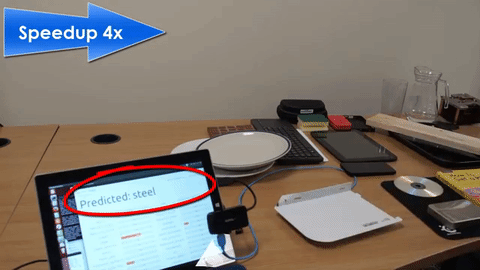So far, humans have had the edge in the ability to identify objects by touch. but not for long. Using Google’s Project Soli, a miniature radar that detects the subtlest of gesture inputs, the [St. Andrews Computer Human Interaction group (SACHI)] at the University of St. Andrews have developed a new platform, named RadarCat, that uses the chip to identify materials, as if by touch.
Realizing that different materials return unique radar signals to the chip, the [SACHI] team combined it with their recognition software and machine learning processes that enables RadarCat to identify a range of materials with accuracy in real time! It can also display additional information about the object, such as nutritional information in the case of food, or product information for consumer electronics. The video displays how RadarCat has already learned an impressive range of materials, and even specific body parts. Can Skynet be far behind?
Again, this could provide robots with a sense of touch, in a manner of speaking, that rivals our own human capacity for object recognition. This has applications for a wide range of robots: industrial machines will be able to recognize the material composition of an object that may require more force to lift while wearable versions would assist humans with disabilities. This is a technology worth keeping an eye on.
While this tech is a ways away from widespread use, you can still turn anything into a touch sensor today with Touché.
[via /r/linux]
















Well, since CueCat came out in 2000, then Skynet should be at least 16 years in the future…
About 10 years ago 2038 was the predicted time frame for the singularity. When available global computing power would match our AI knowledge. But it looks to me like that time frame may have been an under estimate.
What do you expect from humans?
When the AI can predict when the singularity will occur, call me back.
CueCats, I have fond memories of my father and I taking apart a whole box of those as a small child and making custom LED flashlights, toy cars, and whatever else we could think of out of the adorable cyber-cat chassis. My mom worked at Radioshack and managed to take home a bunch of them after they were discontinued.
I wonder if this device could solve the ‘Roomba driving over pet mess’ problem…
Could be useful for idenifying differnt flooring types.
I.e. carpet vs tile.
Very interesting. But using Ubuntu on Surface? oh my
Amazing. How long until there’s one of these in every smartphone?
“even specific body parts”
*raises eyebrow*
The radar’s response when detecting the body part in question: http://i1.kym-cdn.com/photos/images/newsfeed/000/634/005/8d0.gif
Well done & from a nice collection of perspectives, not a common conjunction of skills :-o)
Brilliant, please sign me up, I wanna buy at least 4 & asap, I am into RF sensing & few other related
remote sensing applications in food science/microbiology & my nootropic dosed tree hugger who
has just seen this too. As project manager for several developments I have close tie ins with
several Australian public companies…
radar@niche.ii.net
Thanks :-)
can it detect 5 different apples as all apples without special characterizing of the 5 apples first? Sounds a bit staged thought I am intrigued enough to really want to see what comes of this.
The Soli chip is fantastic, but presently there are only 60 or so groups globally with alpha access to it.
Will it ever become a “product” with open availability, or will it become Glass all over again?
I am tired of vaporware. Give me an article on something that is not a paper tiger from AMD, a hodge podge idea from Kickfailtostart, or an attention grubbing clickbait title.
Deliver a technical article or show us a novel concept. I am tempted to go back to my roots and read Mims all over again. Functional simplicity is simply more attractive to most of us at this point. Better yet start paying the community to write technical articles if you are not already…
What chip are they using. Did I miss it on the page or one of the links?
I have ordered 16 radar motion detectors last month and am wondering if they are the same ones.
I am planing to use them to detect everyone in the house so the house knows whos home.
and turn on or off what is needed for them.
But if they can do more then that i am very interested.
They are the google radar chips designed for gesture control. Not what you have.
and thus, we are one step closer to a real life tricorder.
GIMME.
If it built to work inside a microwave it could detect and properly heat food and also reject dangerous items